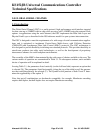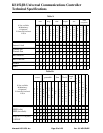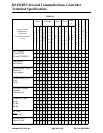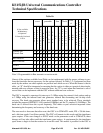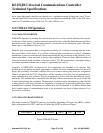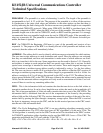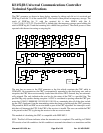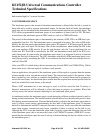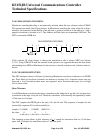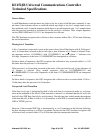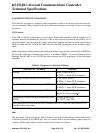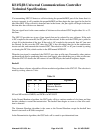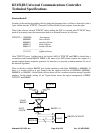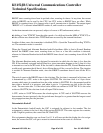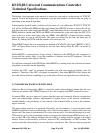
KS152JB Universal Communications Controller
Technical Specifications
Kawasaki LSI USA, Inc. Page 40 of 120 Ver. 0.9 KS152JB2
link remains high for 2 or more bit times.
3.2.3 INTERFRAME SPACE
The interframe space is the amount of time that transmission is delayed after the link is sensed as
being idle and is used to separate transmitted frames. In alternate back off mode, the interframe
space may also be included in the determination of when retransmissions may actually begin. The
C152 allows programmable interframe spaces of even numbers of times from 2 to 256. The hard-
ware enforces the interframe space in SDLC mode as well as in CSMA/CD mode.
The period of the interframe space is determined by the contents of IFS. IFS is an SFR that is pro-
grammable from 0 to 254. The interframe space is measured in bit times. The value in IFS multi-
plied by the bit time equals the interframe space unless IFS equals 0. If IFS does equal 0, then the
interframe space will equal 256 bit times. One of the considerations when loading the IFS is that
only even numbers (LSB must be 0) can be used because only the 7 most significant bits are
loaded into IFS. The LSB is controlled by the GSC and determines which half of the IFS is cur-
rently being used. In some modes, the interframe space timer is re-triggered if activity is detected
during the first half of the period. The GSC determines which half of the interframe space is cur-
rently being used by examining the LSB. A one indicates the first half and zero indicates the sec-
ond half of the IFS.
After reset IFS is 0, which delays the first transmission for both SDLC and CSMA/CD by 256 bit
times (after reset, a bit time equals 8 oscillator clock periods).
In most applications, the period of the interframe space will be equal to or greater than the amount
of time needed to turn -around the received frame. The turn-around period is the amount of time
that is needed by user software to complete the handling of a received frame and be prepared to
receive the next frame. An interframe space smaller than the required turn-around period could be
used, but would allow some frames to be missed.
When a GSC transmitter has a new message to send, it will first sense the link. If activity is
detected, transmission will be deferred to allow the frame in progress to complete. When link
activity ceases, the station continues deferring for one interframe space period.
As mentioned earlier, the interframe space is used during the collision resolution period as well as
during normal transmission. The backoff method selected affects how the deference period is han-
dled during normal transmission. If normal backoff mode is selected, the interframe space timer is
reset if activity occurs during approximately the first half of the interframe space. If alternate
backoff or deterministic backoff is selected, the timer is not reset. In all cases when the interframe
space timer expires, transmission may begin, regardless if there is activity on the link or not.
Although the C152 resets the interframe space timer if activity is detected during the first one-half
of the interframe space, this is not necessarily true of all CSMA/CD systems. (IEEE 802.3 recom-
mends that the interframe space be reset if activity is detected during the first two-thirds or less of
the interframe space.)



